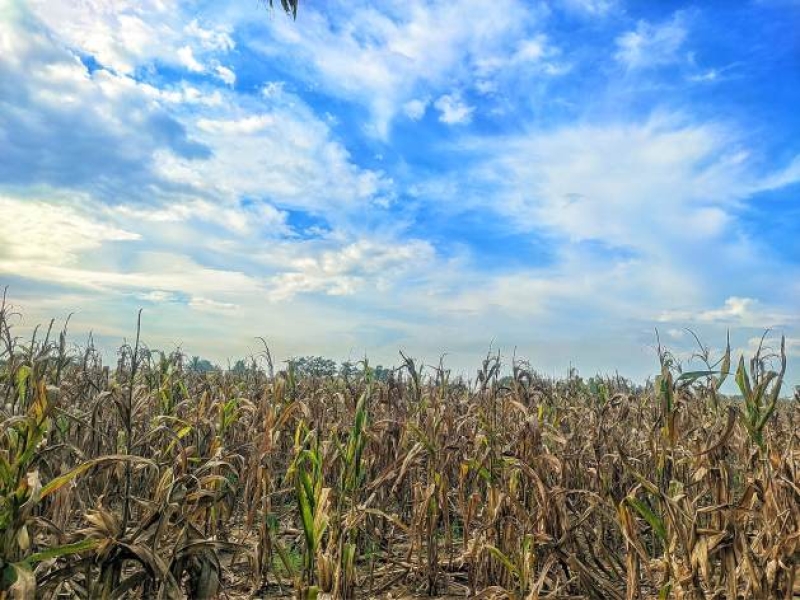- CA Yunus pays homage to Liberation War martyrs on Victory Day |
- Bangladesh capital market extends losing streak for second day |
- Bangladesh celebrates Victory Day Tuesday |
- 'Different govts presented history based on their own ideologies': JU VC |
Extreme Weather Threatens U.S. Crop Yields and Soil Health

Heatwaves and floods are damaging essential crops like corn, wheat, rice, and tomatoes—threatening food and nutrition security.
Recent weeks have seen an increase in extreme weather events, from heatwaves across Midwestern states to flash flooding in Texas, Maryland, and New York.
Although these events have had significant and measurable impacts on humans, the detrimental effects on agriculture rarely make headlines—a lack of coverage that must change.
Most concerning is the noticeable gap in dialogue and focused attention by researchers, policymakers, and other key stakeholders in agricultural crop production and food systems—a gap that urgently needs to be addressed.
It’s time for researchers, policymakers, governments, media, and stakeholders across agriculture and food systems to engage more urgently in how these events affect not just humans, but also agricultural crops and the microbial communities that support soil and plant health.
Heat and flooding impact crops such as corn, wheat, rice, and vegetables including tomatoes—crops we depend on for food and nutritional security.
These impacts can range from changes in growth patterns to acres of crops being decimated, and tons of vegetables rendered unsellable due to potential contamination from floodwaters. All these losses carry a significant economic cost.
For example, the University of Arkansas System Division of Agriculture estimated crop-related flooding damage in Arkansas in 2025 at $78.9 million.
Indeed, recent research from institutions and universities across the United States shows that extreme weather negatively impacts crop growth and yields, reduces revenue, raises consumer prices, and increases crop insurance payouts.
Heatwaves and flooding also affect plant physiology and metabolism—disrupting vital processes such as photosynthesis, respiration, antioxidant defense systems, and reactive oxygen species scavenging. These disruptions hinder plant development and result in reduced productivity.
Ultimately, farmers lose crops and income, and these losses are passed on to consumers through higher food prices. For instance, the American Farm Bureau Federation reported that U.S. farmers lost $20.3 billion in 2024 due to weather disasters including flooding and heatwaves.
Extreme weather also affects belowground microbes that are essential to soil health and function. Soil microbiomes govern key biogeochemical processes, including nutrient and water cycling. Both beneficial and pathogenic microbes are disrupted by flooding.
Flooding, for instance, can deplete beneficial soil microbes and affect organisms like earthworms. Since belowground processes are tightly linked to aboveground plant health, any disruption underground impacts crops.
Importantly, researchers are rising to the challenge, seeking ways to mitigate the damage caused by extreme weather during and after such events.
In the case of flooding, emerging studies show that applying nitrogen-based fertilizers immediately after floods can help plants recover. However, this is not a sustainable solution due to nitrogen’s harmful effects—such as groundwater contamination and greenhouse gas emissions.
Therefore, researchers must explore beyond nitrogen.
Fortunately, the agricultural market offers sustainable bioproducts like biostimulants and microbial inoculants. These contain beneficial live microbes such as mycorrhizal fungi and nitrogen-fixing bacteria and show potential in mitigating weather impacts. Their use merits further exploration.
Encouragingly, progress is underway. For example, a recent study found that foliar spraying of tomato plants with beneficial microbes improved their tolerance to heatwaves. Review papers are also emerging to summarize findings and suggest future research directions.
Funding this line of research is essential—especially to address current challenges, including lack of regulation, inconsistent terminology, and concerns over mutations in introduced microbes. The biostimulant market is projected to reach USD 7.84 billion by 2030.
Equally important are long-term solutions. Regenerative agricultural practices, such as using cover crops, offer promise. Research shows that cover crops can reduce flooding impacts and enhance resilience to extreme weather.
Cover crops—grown mainly to improve water infiltration, soil health, and prevent erosion—help absorb excess water and improve soil structure. Although adoption in the U.S. rose 17% between 2017 and 2022 (based on satellite analysis of 100,000 fields), more research is needed to address their limitations.
Future projections indicate that extreme weather will only intensify and occur more frequently.
It’s imperative that researchers, policymakers, and agricultural stakeholders urgently recognize how these events threaten both crops and soil microbial communities.
By documenting these impacts and funding science-based, sustainable solutions, we can better prepare for an increasingly uncertain climate future. The time to act is now.
Esther Ngumbi, PhD, is an Assistant Professor in the Department of Entomology and African American Studies at the University of Illinois at Urbana-Champaign.

